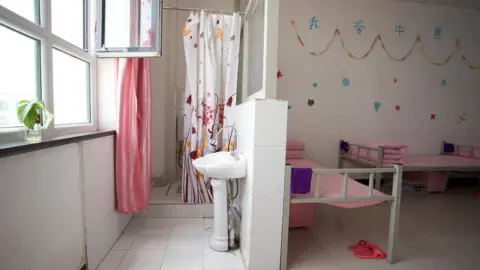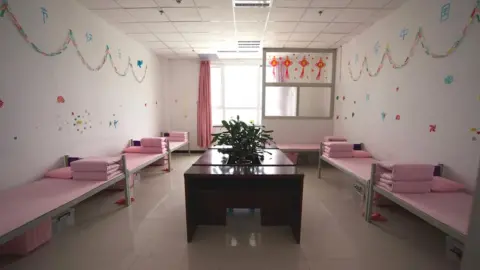Searching for truth in China's Uighur 're-education' camps
 BBC
BBCThe Chinese region of Xinjiang is home to millions of ethnic Muslim Uighurs who have lived there for decades. Rights groups say hundreds of thousands have been detained in camps without trial, but China argues they voluntarily attend centres which combat "extremism". The BBC went inside one of them.
I'd been to the camps before.
But the closest I'd managed to get on previous visits were snatched glimpses of the barbed wire and watchtowers from a passing car, while the plainclothes police officers tailing us tried to stop us getting any closer.
Now I was being invited inside.
The risks of accepting were obvious. We were being taken into places that appeared to have been carefully spruced up - with satellite images revealing that much of the security infrastructure had recently been removed.
And one by one the people we spoke to inside, some of them visibly nervous, told us similar stories.

All of them members of Xinjiang's largest, mainly Muslim ethnic group - the Uighurs - they said they'd been "infected by extremism" and that they'd volunteered to have their "thoughts transformed".
This was China's narrative in the mouths of people selected for us, and for whom any cross-examination might pose a serious risk.
What might be the consequences if they did let something slip? How could we safely separate the propaganda from the reality?
Radicalised and reborn
There are plenty of precedents for this kind of reporting dilemma.
There was the heavily managed 2004 press tour of the US-run Abu Ghraib prison in Iraq, in the wake of the abuse scandal, with reporters herded away from detainees clamouring to have their voices heard, some while waving their prosthetic legs.
Or there's the example of the rare and restricted media access to Australia's offshore immigration detention centres.
And in the 1930s and 1940s, Germany organised media trips to camps at Sonnenburg and Theresienstadt, designed to demonstrate how "humane" they were.
In all such cases, the reporter is witness to a story of vital global importance, but forced to try to tell it with only limited or highly controlled access to those most affected by it.
In Xinjiang though, there is one big difference. The authorities grant access not only to show that the conditions inside the facilities are good, they also want to prove that they are not prisons at all.
We were shown adults seated in rows at school desks in brightly lit classrooms, chanting in unison while learning Chinese.

Some performed highly staged and choreographed music and dance routines for us, wearing traditional ethnic costumes, whirling around their desks, smiles fixed in place.

And what was quite clear was that the Chinese officials accompanying us believed wholeheartedly in the narrative on display, some almost moved to tears as they looked on.
These people, we were urged to recognise, were reborn. Once dangerously radicalised and full of hatred for the Chinese government, they were now safely back on the road to reform thanks to the timely, benevolent intervention of that same government.
The West could learn a lot from this was the message.
Referring to the date the re-education policy began, one senior official looked me sternly in the eye.
"There has not been a single terror attack in Xinjiang in 32 months," he said. "This is our patriotic duty."
'Oh my heart don't break'
But in accepting the access, our job was to try to peer beneath the official messaging and hold it up to as much scrutiny as we could.
There were the bits of graffiti we filmed, written in Uighur, that we later had translated.
"Oh my heart don't break," read one. Another in Chinese said simply: "Step by step."

There were the answers, in extended interviews with the officials, that revealed much about the nature of the system.
Those in it were "almost criminals," they said, viewed as a threat not because they'd committed a crime, but because they might have the potential to do so.
And there was the admission that, once identified as having extremist tendencies, they were given a choice - but not much of one.
The option was "of choosing between a judicial hearing or education in the de-extremification facilities".
"Most people choose to study," we were told. Little wonder, given the odds of a fair trial.
And we know, from other sources, that the definition of extremism is now drawn very widely indeed - having a long beard for example, or simply contacting relatives overseas.
We saw the dormitories in which these "extremists" slept, up to 10 per room, in bunk beds and with a toilet at one end, shielded with only a thin sheet of fabric.


And then there was the cautious questioning that revealed much, not in what they could say, but what they couldn't.
I asked one man, who'd been there for eight months already, how many people he'd seen "graduate" in that time.
There was a slight pause before he answered. "About that, I have no idea," he said.

Just one voice from within a giant system of mass internment thought to hold more than a million people on the basis of their ethnicity and their faith.
However faint and muted, we should listen carefully to what such voices might be telling us.
